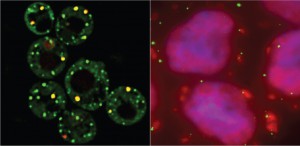A key means by which all eukaryotic cells enact appropriate gene expression responses is to alter the function of messenger RNAs (mRNAs). mRNAs exist in different functional states (Figure 1), include translation (protein synthesis), repression (off state) and a decay-primed state. The localization of mRNAs is also highly regulated, thus altering mRNA function affords cells an array of spatial and temporal mechanisms for gene expression control.

mRNAs can cycle between these different functional states. For example, mRNAs exiting translation often accumulate in distinct mRNA-protein (mRNP) assemblies known as P-bodies and stress granules (Figures 2-3), from which they may either be stored, degraded or ultimately return to translation again. P-bodies and stress granules are conserved throughout eukaryotes, contain important protein regulators of decay and translation, and thus affect gene expression control. In addition, they strongly resemble other important mRNP granules that function in embryogenesis (maternal/germ granules) and memory formation (neuronal transport granules). Finally, these granules have numerous connections to disease, such as an involvement in RNA viral replication, elevated levels in certain cancer types, as well as the formation of apparently aberrant stress granules in neurodegenerative diseases such as ALS.

In the Buchan lab, we use yeast and cell line models to study the architecture, dynamics and regulation of the cytoplasmic mRNP cycle. Our overall goal is to better understand what factors contribute to the regulation of specific mRNAs, and the importance of the mRNP cycle in this process.
Specific projects:
Granulophagy and stress granule purification
Endocytic clearance of TDP-43 and FUS; aggregation prone proteins linked to ALS pathology
mRNA scaffolding of P-bodies + 3’UTRs as drivers of nascent protein interactions
Determining connections between nuclear and cytoplasmic mRNA events